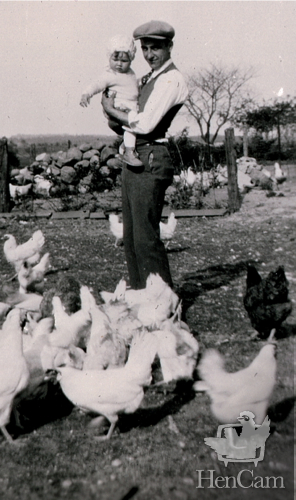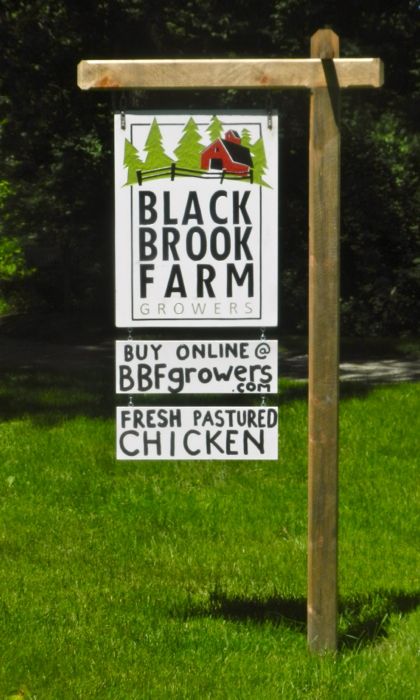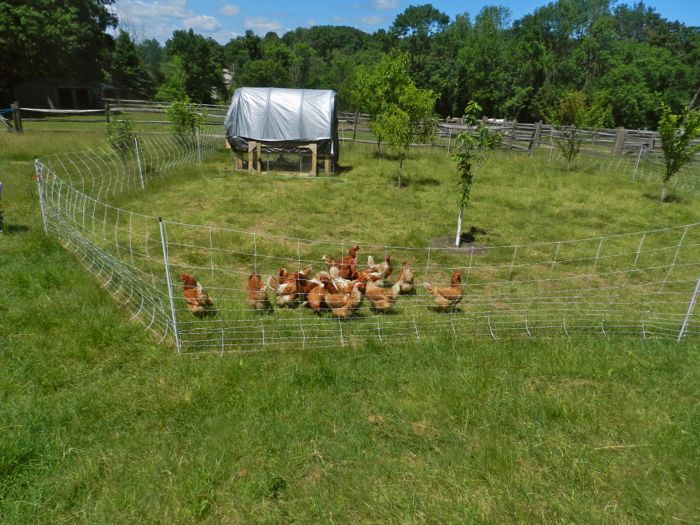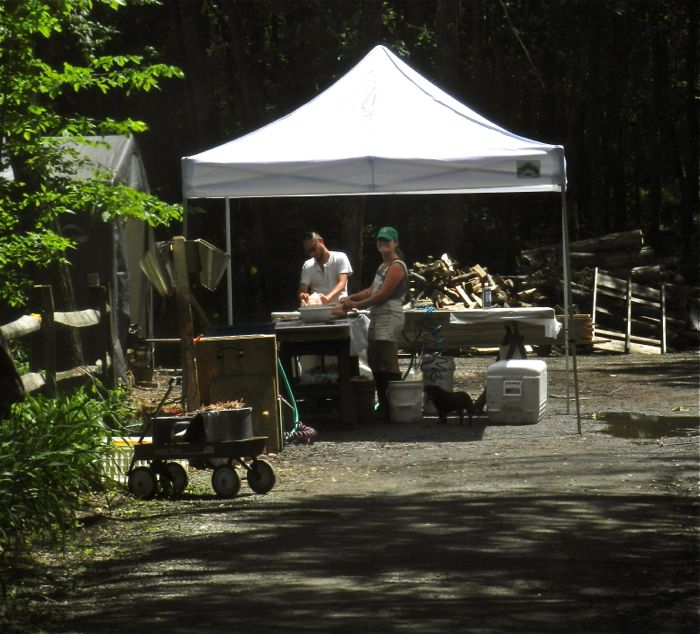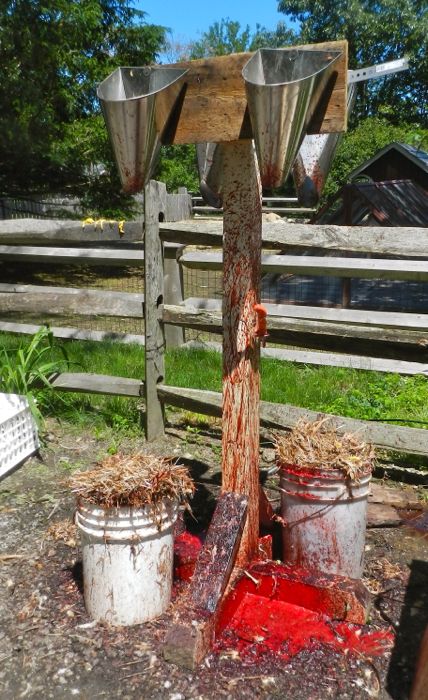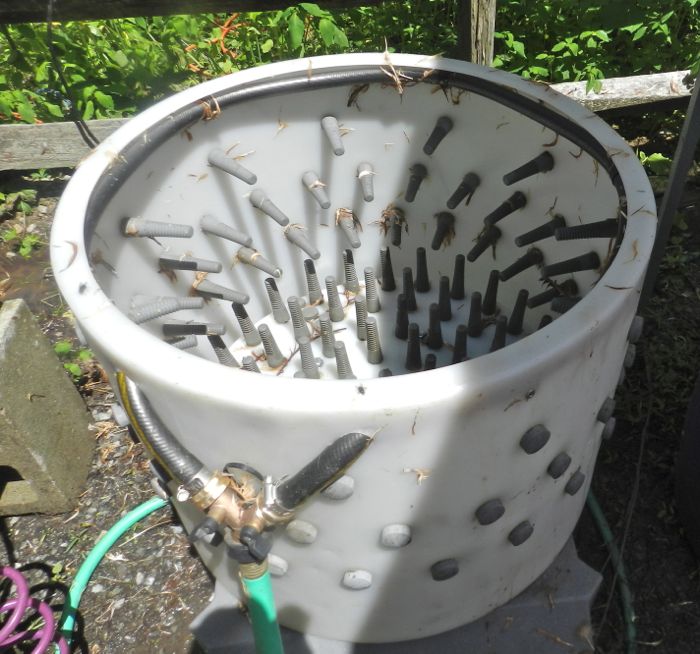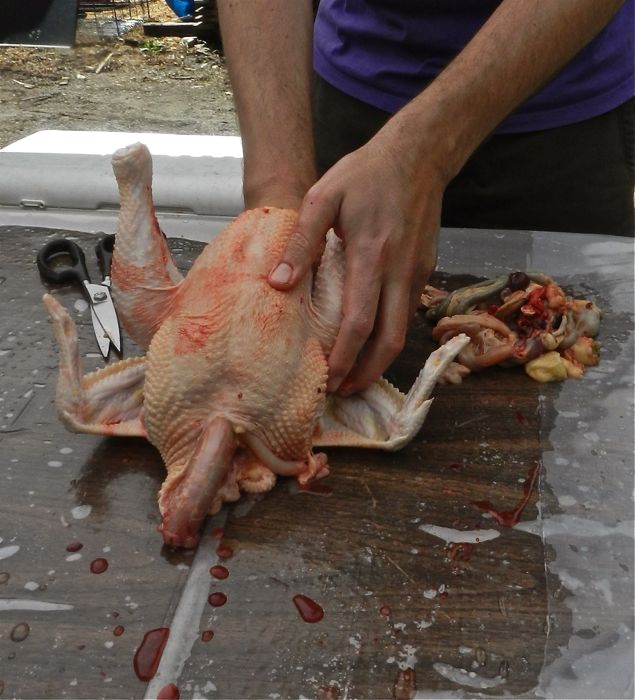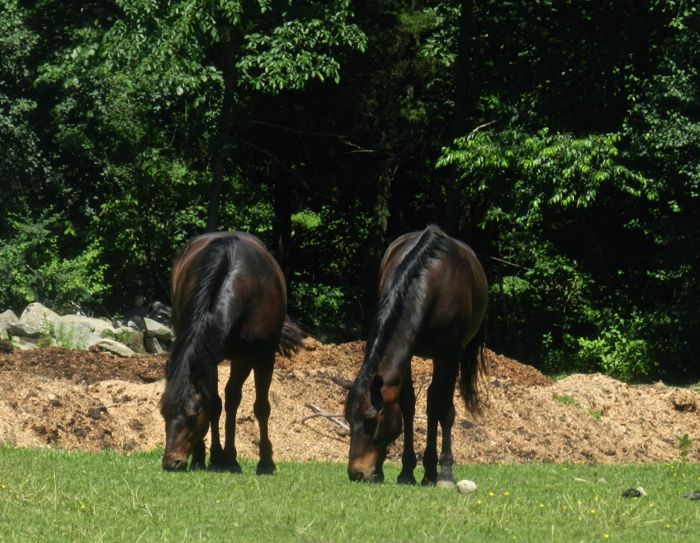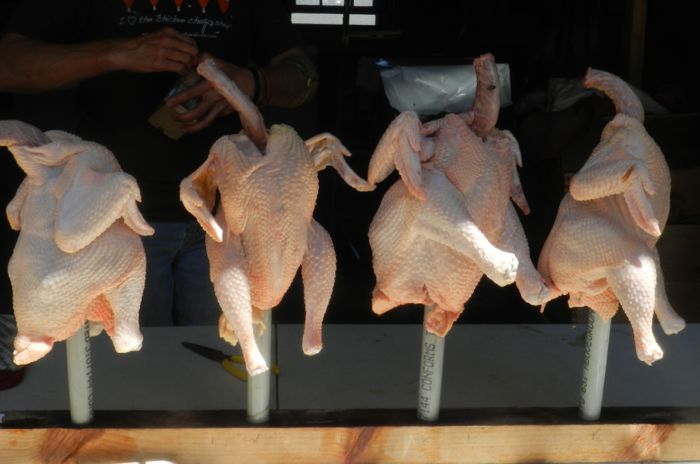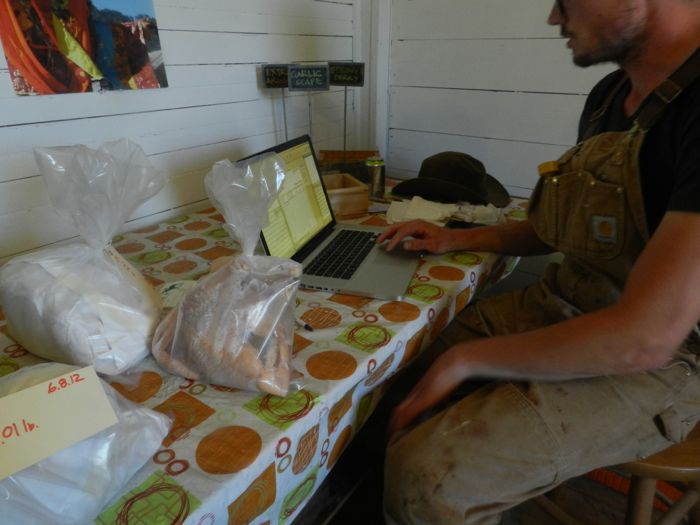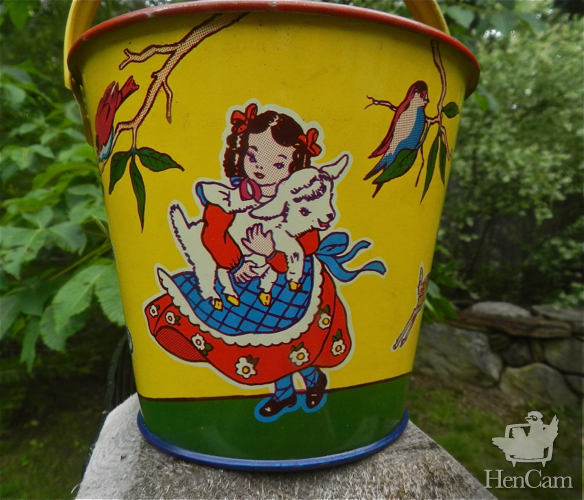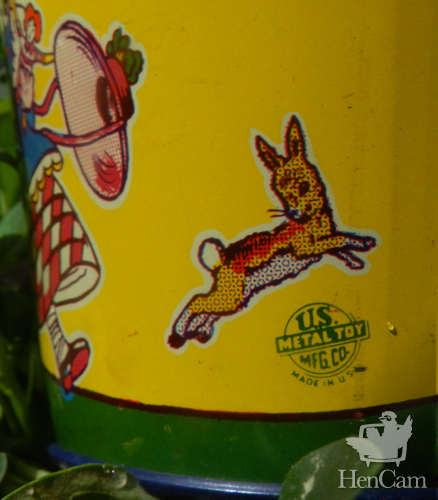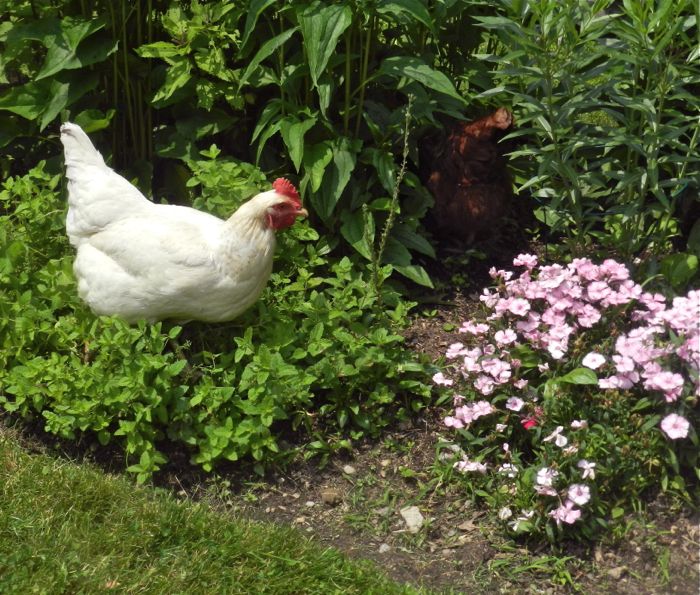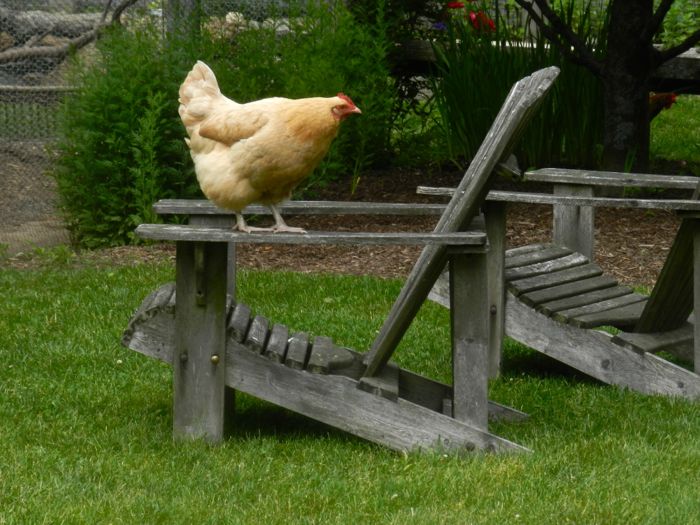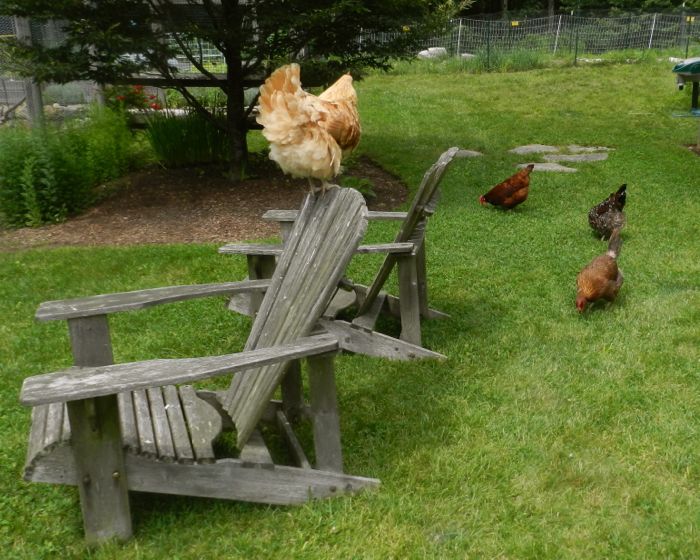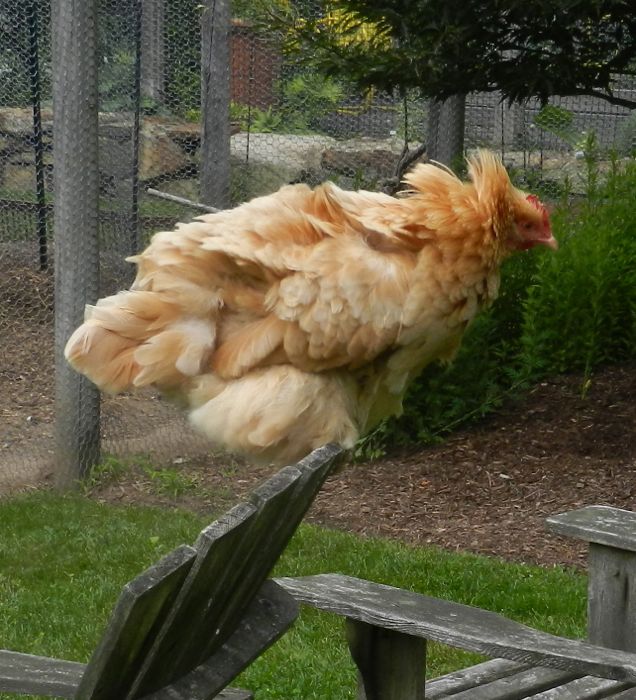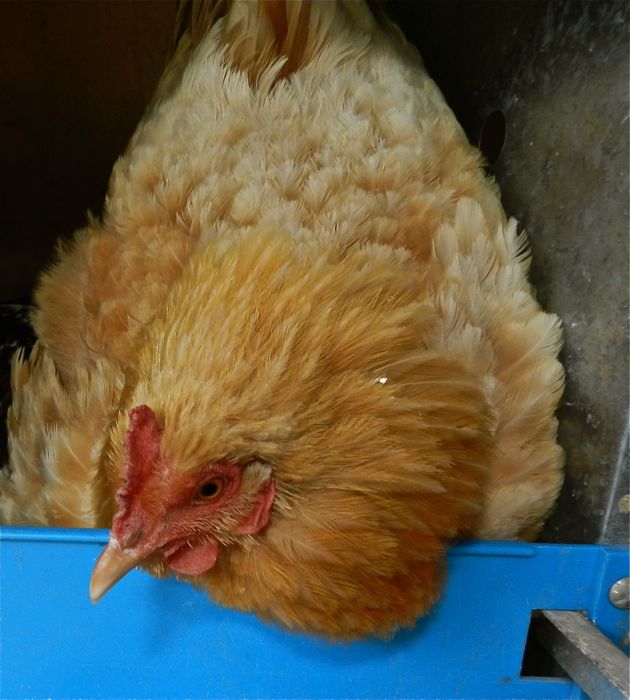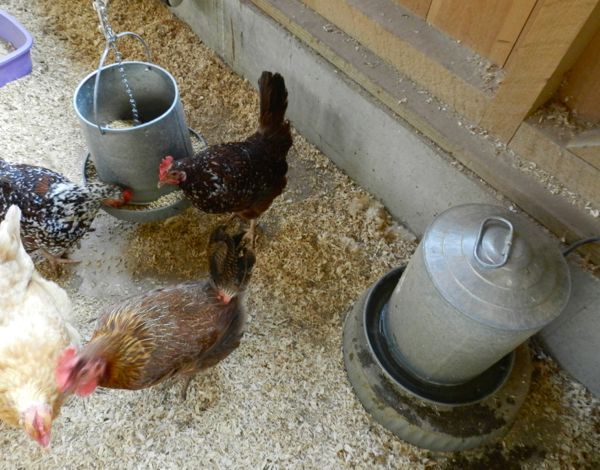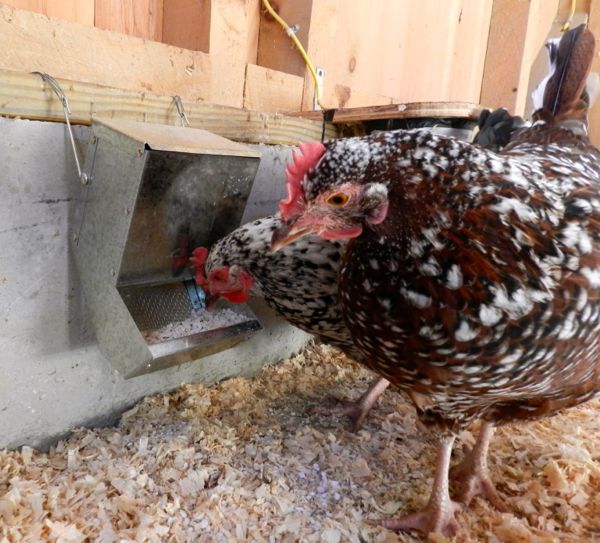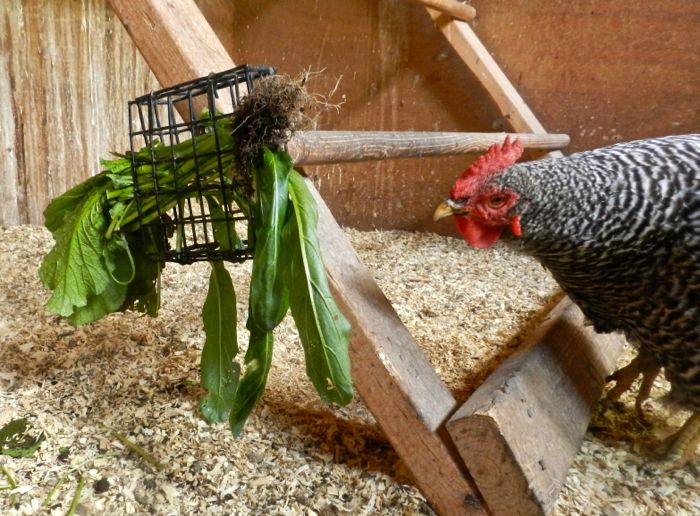Greetings to all of you with fathers who have held you while standing amidst the chickens, and to those of you who are the men that did the holding. Thank-yous to fathers who have built coops, to those who have bought chicken feed, and to dads who have driven a hundred miles with chickens in the back of the car to go to a 4-H fair. Happy Father’s Day to dads who have never held a hen, but have held a child and crowed “cock-a-doodle-doo” while reading a story. Much appreciation to all dads who have enabled their children, one way or another, to have chickens in their lives.
Monthly Archives: June 2012
The Chicken I Eat
I’m not a vegetarian. I believe that animals have a place in agriculture and in our diet. Meat raised on pastures and on farms that integrate animals into the whole picture is a sustainable and conscientious food source. On the other hand, meat produced in confined feed lots and in concrete buildings is wrong on many levels. I limit my consumption of such meat, but I’m not a hard-core locavore. If my friend, who makes the best fried chicken in the entire world, invites me over for dinner, I’ll be there in flash (hint, hint, Giuia.) If I’m at a restaurant and the most interesting item on the menu is chicken, I’ll order it. The reality is that the poultry industry is a trillion-dollar, world-wide business. My buying power isn’t going to make even a pin-prick of a dent if I opt out.
On the other hand, my buying power makes a world of difference to the small farmer who is doing animal agriculture right. All of the red meat and pork in my freezer is purchased from local farms. Up until recently the best choice I’ve had for poultry is to buy organic at the regular market. Organic doesn’t necessarily mean that the chickens were uncrowded or out in sunshine, but they are raised better than the regular supermarket birds. Fortunately, now I have a better option than organic. Two young and idealistic people started a farm in my town.
They are raising chickens for meat and eggs. On pasture.
In Massachusetts, a farmer is allowed to raise up to 1,000 chickens to slaughter and sell on the farm. Beyond that number, the birds have to go to a slaughterhouse, where the added fee of processing puts the meat out of the range of most consumers. Yesterday was slaughter day. David, Gallagher and volunteers processed their flock. They set up a tent and their equipment.
It is bloody, messy, and physically demanding work.
These are the killing cones.
It looks gruesome, but at least their birds did not get shoved into crates and shipped. They were handled with care and respect up until the end, and the end was quick.
Then the feathers got removed in this contraption.
Next, the birds were kept in ice water until they were gutted and trimmed. Remaining feathers were plucked.
Because this is a farm with horses, there are large manure piles. Using a tractor, the offal was buried in the compost.
The finished birds were bagged, and then refrigerated or frozen.
I bought three birds. $5 per pound. 4 pounds per chicken. $60. I don’t compare it to what I’d pay at the supermarket. It’s a totally different product. The man taking my money is the man who raised and slaughtered the animals.
This chicken comes from a farm that has a real barn. I’m hoping that my support helps to keep animals on the property, on pasture, and that this barn remains filled with hay and the smell of a working farm for years to come.
We’re going to have roast chicken and new potatoes for Father’s Day dinner. I’ll be thanking the farmers and the animals they raised.
Due to state regulations, Black Brook Farm Growers cannot ship, but if you’re anywhere in the area, you can go on-line to order and then pick up in person. Tell them I sent you.
Sunny Day Pail
A Broody Hen’s Outing
We’ve had a span of rainy weather and the hens were stuck inside their pens. But the other day there was a break, the sun appeared, and I had the time to sit outside with the girls and watch for hawks while they free-ranged. When I swung open the door to the run, they all barged out, grabbing at grass and running off to the flower beds.
(This photo illustrates exactly why the girls were not allowed out before the garden tour! What you miss in this still is Opal’s vigorous scratching right on top of the flowers.)
That is, all of the hens rushed out except for Topaz. Topaz is broody again. She is the quintessential broody – huffy, bad-tempered, and ruffled up to twice her size. But she doesn’t intimidate me. I unceremoniously extracted her from the nesting box and tossed her onto the lawn. After some grumbling, she noticed the Adirondack chairs.
Topaz went as high as she could, the perfect position to lord it over the other hens.
She made a big show of feather ruffling and preening.
Nobody looked her way, but it did set her off-balance.
How annoying!
So Topaz complained all the way back to the nesting box, where her fowl foul mood continues.
What To Feed Your Chickens
What chickens eat and what chickens should eat are not always the same thing. Chickens are omnivores. That means they’ll snarf down just about anything, or at least try to! I’ve seen a hen catch and slurp down a snake like spaghetti. I’ve seen a chicken snatch a toad by it’s leg and all of the other hens go in a raucous chase after it, only, at the end to discover that a toad is not good eating. Chickens also eat less exciting foods, like vegetables, fruits, flowers and grass. They eat grains and seeds. They scratch the ground and find bugs and specks of things that we can’t see. So, the question isn’t really what chickens eat, but what the right diet is for them.
In the 19th century most chickens were barnyard scavengers. They hatched out under their mamas and were taught to look for grain in the horse stalls, and for bugs and greens in the garden. The farm wife tossed stale bread and kitchen scraps to the hens. Chickens destined for the table were fattened on sour milk. Sometimes, in the winter, they’d be given a handful of grain. The hens back then laid only a few eggs a week. This haphazard diet was enough sustenance for them. But, flocks became larger and more confined. Chickens were bred to lay more and more eggs. Instead of 90 eggs a year, a hen now might lay over 300. With the increase in egg production came an increase in the nutritional requirements of the flock.
Laying Hen Pellets
Commercial laying hen pellets (or crumbles which are the same thing but smaller) are designed for today’s productive hens. Creating a daily egg is depleting. The pellets have the right proportion of protein, minerals and energy for the chickens. These pellets should make up the bulk of your flock’s diet. Your chickens should have access to the pellets all day long. They should go to bed with full crops (the crop is the pouch in their throat where the food is first stored after it is swallowed.) It takes over 25 hours to create one egg. During the night, as the hen is sleeping, she is still building that egg. She gets the materials for making that egg from digesting food. If her digestive tract is empty she can’t make the egg. So, let your hen eat what she wants from sunup to sundown.
Oyster Shell and Grit
Even though the commercial feed contains calcium, it is good to provide another source. Coarsely broken up oyster shell is the most easily absorbed form (even better than finely-ground.) I put it in a rabbit feed hopper, which keeps it tidy and prevents waste. Chickens also need grit – tiny rocks- that the hens need so that their gizzards can grind up food. Without grit, digestion is slowed and the hens are less efficient at extracting nutrients from feed. Like oyster shell, grit should be offered free choice.
Vegetables, Table Scraps and Free-Ranging
As good as it is, commercial feed should not be the only thing that your hens eat. A standard-sized hen will eat between 1/4 and 1/3 pound of pellets a day, if it’s the only food offered. However, it remains essential for our backyard hens to have a varied diet beyond the pelleted ration. Greens and dirt to scratch in are key components to keeping your flock healthy. If you can let your hens free-range, they’ll find plenty to eat. However, for those of us who live where there are severe winters, or who keep hens on small lots, or have too many predators to allow free-ranging, you have to provide a varied diet in other ways.
Chickens appreciate table scraps. They’ll eat most anything, from coffee grinds to stale toast to soggy green beans. Some things they won’t eat, and sometimes it’s a matter of personal preference. Mine don’t like raisins, and yet it’s a favorite treat for a friend’s flock. Not all of the foods tossed in the compost pile are ideal for chickens, but if your hens are getting most of their food intake from laying hen pellets, then it’s unlikely that they will overeat any one item in the scrap pile. There’s only one item that I know of that is lethal to chickens and that is avocados. Contrary to what you might have read out there, potato skins and eggplant leaves aren’t going to cause any harm. But, some foods are better than others. If you offer too many carbs, like bread and stale cereal, your hens will get fat and won’t get enough protein. So, dole those out judiciously. In the summer, you can toss all of your garden waste, including bug-softened zucchini, weeds and grubs in with your chickens. Your hens will eat what they like and shred the rest. I don’t give them grass clippings, as that can cause impacted crops. The same goes for long scallion stalks. But, it’s not a good idea to simply throw kitchen scraps and garden waste into the run, as it will become a mess. To keep everything tidy and healthy I have a compost bin in the chicken run. What the hens don’t eat gets churned into tiny bits and quickly turns into good dirt. It’s an easy, healthy system.
In the winter, when the compost bin is frozen, I hang cabbages inside the coop for rousing games of cabbage tether ball. I also put treats in suet feeders. Outside, I’ll cut a hole in a pumpkin and the hens will spend days pecking at it – even when frozen it will keep them busy and healthy.
Scratch Grains, Meal Worms and Other Treats
We all love to give our hens treats. Unlike so many others in our lives, chickens are raucously grateful for the smallest offerings. But, I’ve seen a disturbing trend to over-indulgence in the feeding of backyard hens. You can make your chicken sick – or even kill her – with too many of the wrong treats. One food that chickens love is cracked corn. It’s like candy to them. But, it has no nutritional value other than calories. It’s okay to give a little in the winter when the weather is really cold, but otherwise it has no benefit. It does quickly make hens fat, which can lead to serious egg-laying glitches. So, as much as your girls are gleeful about cracked corn, don’t feed it.
On the other end of the spectrum, I am especially concerned about all of the people feeding their hens mealworms. A small amount, like a tablespoon a day, is a fine treat. But, people are feeding handfuls. They’re practically feeding their hens pure protein (mealworms are up around 50%) The chicken expert at my local feedstore just told me about hens dying from kidney failure due to being fed mealworms as the main part of their diet. Besides the health dangers, mealworms are very expensive. Yes, it’s good for chickens to eat bugs, bugs they have worked for and found themselves, bugs that are part of an active life, and one in which the insects are part of other things that the chickens are sorting through and ingesting. A chicken should have to work for her treats, by scratching and exploring. Chickens should fill their crops over the course of a long day, not at one time. Tossing in a large handful of mealworms or corn to your hens is the exact opposite of what is best for them. Because hens that are active and outside are the healthiest, I keep a compost pile in the chicken run. It keeps them busy scratching and there’s always bugs and tidbits for them to find and eat.
Hulled sunflower seeds are a nice treat – in moderation. They have that extra bit of protein, and also contain good essential fats. My retired girls get about a teaspoon per bird per day. Plenty! Don’t feed the seeds with the shells on, as too many can cause an impacted crop. The sunflower seeds, and sometimes a small bit of cracked corn) are what I use to call my hens. If you’ve seen my YouTube video, you know how fast my hens come when called. Since they rarely get such treats, when they hear that can shake, they know something very, very special is waiting for them.
You might see large, solid blocks of chicken treats a the feed store and are supposed to be placed outside for foraging hens. These blocks attract chipmunks and mice to your run, and they don’t encourage the hens to move about and search for food. They also are sweet and so the hens prefer it to their pellets. If your girls are stuck indoors during the winter, a block can keep them busy. Otherwise, I don’t think they’re a good idea.
But all of this doesn’t mean that you can’t spoil your hens. A piece of crumbled stale bread, a bowl of yogurt, a bruised tomato, will all cause a happy commotion in the chicken yard.
Water
The one most essential thing to provide your flock is fresh water. Even though it does seem as if chickens prefer muddy pools (rather like toddlers in a rain puddle) always have clean water for them. Put the water font up off the ground (a few bricks work for this) so that it stays clean. Scrub the water font weekly. In the winter, if you are located in an area with freezing temperatures, either use an electric heating stand under the waterer (these are designed for chicken waterers) or be prepared to swap frozen waterers for fresh several times a day. A chicken without water will die within a day. In the summer I put an extra waterer out in the pen near the shady area where the hens like to hang out. Chickens overheat easily and water will go a long way to keeping them healthy and alive.
To wrap it up, what your hens need are laying hen pellets, fresh water, greens, fresh air and exercise. Indulge them by giving them an interesting environment, compost to shred, and your delighted attention. Once in awhile, toss them something really special (but keep it special by doing this sparingly!) Your treat will be having healthy, active, laying, hens.
Feeding Chicks
For the first two days of life the chick makes use of the yolk that is still inside of it. After that, the chick needs food and water. Chicks should be given free-choice finely ground feed that is 18% protein. They shouldn’t eat laying hen pellets because it is too high in calcium and too low in protein. The easiest way to feed chicks is to purchase chick starter. Do not purchase chick finisher or special “grow” feeds, as those are for meat birds that are slaughtered before maturity. Chicks remain on the chick feed for the first 14 to 18 weeks, which is about when they are mature enough to lay. Some people use medicated feed to protect the chicks against a protozoan disease called coccidia. I don’t believe in using medicated feeds unless the chicks show symptoms of illness. So far, I’ve never had to use it.
Most chicks are kept in brooders, which are essentially heated boxes bedded with pine shavings. These are safe places for the chicks to grow but not ideal. I think it is essential to give the chicks a clod of dirt with some greens attached the first week. The clump of earth is beneficial to the chicks in many ways. It exposes them to small amounts of local microbes so that they develop natural immunity. It gives them something to do, as even chicks get bored! It gets a bit of grit into their gizzards. Most importantly, it teaches the chicks to peck the ground and not each other. Providing that clod of dirt will greatly reduce aggression and pecking issues later. Do make sure, though, that there isn’t fine grass clinging to it. The greens should be sturdy so that the chicks peck little bits off. Dandelions are perfect for this. You don’t want them getting impacted crop from fine blades of grass. It is tempting to give the chicks other treats as well, everything from sunflower seeds to strawberries. But, remember that if the chicks were outside with a mamma, that they’d be moving and eating tiny bits of things and not standing still and gorging. You can give them treats, but in very small amounts, and make sure that they fill up on chick feed first. As soon as it is warm enough the chicks can go outside and peck and eat whatever they want. Just make sure that the bulk of their diet is a balanced chick feed that they get free choice.
For more about feeding chickens for the first 20 weeks, go here.
